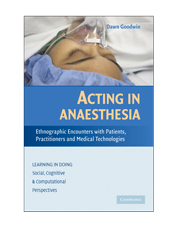Book contents
- Frontmatter
- Contents
- Series Foreword
- Acknowledgements
- Acting in Anaesthesia: Ethnographic Encounters with Patients, Practitioners and Medical Technologies
- 1 Understanding Anaesthesia: Theory and Practice
- 2 Refashioning Bodies, Reshaping Agency
- 3 Accounting for Incoherent Bodies
- 4 Teamwork, Participation and Boundaries
- 5 Embodied Knowledge: Coordinating Spaces, Bodies and Tools
- 6 Recognising Agency, Legitimating Participation and Acting Accountably in Anaesthesia
- References
- Index
- Titles in the series
1 - Understanding Anaesthesia: Theory and Practice
Published online by Cambridge University Press: 20 August 2009
- Frontmatter
- Contents
- Series Foreword
- Acknowledgements
- Acting in Anaesthesia: Ethnographic Encounters with Patients, Practitioners and Medical Technologies
- 1 Understanding Anaesthesia: Theory and Practice
- 2 Refashioning Bodies, Reshaping Agency
- 3 Accounting for Incoherent Bodies
- 4 Teamwork, Participation and Boundaries
- 5 Embodied Knowledge: Coordinating Spaces, Bodies and Tools
- 6 Recognising Agency, Legitimating Participation and Acting Accountably in Anaesthesia
- References
- Index
- Titles in the series
Summary
After changing into my theatre ‘blues’ I walk down the corridor and check the work allocation – Theatre 1, General Surgery. I begin by checking the anaesthetic machines, both in the anaesthetic room and in theatre. I turn the gases on and disconnect the pipeline supply – the alarms sound. Turn on the cylinders to check the back-up supply – turn them off and reconnect the pipelines. Next, the breathing circuit and ventilator: Any leaks? Leave it functioning but disconnected and wait for the low-pressure alarm, occlude the end and listen for the high-pressure alarm. Check the suction – clean, connected and working? Finally, top up the volatile agents. This work is quiet, constant and regular; there is no need to talk, the familiar routine is comforting first thing in the morning, and the solid and tangible machines are a reassuring presence.
These are some of the general checks. I then need to think about the specifics: Which surgeon, which anaesthetist and what procedures are on the operating list? Mindful of their preferences, I begin to set up for the first ‘case’. Patients are always talked about like this in operating theatres, as ‘cases’ or procedures such as ‘a mastectomy’ or ‘a hip replacement’. It might also be depersonalising, but for me, its utility is as a specific way to think about the morning's workload, to anticipate the likely requirements of the morning.
- Type
- Chapter
- Information
- Acting in AnaesthesiaEthnographic Encounters with Patients, Practitioners and Medical Technologies, pp. 1 - 32Publisher: Cambridge University PressPrint publication year: 2009



